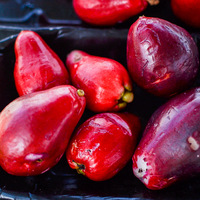Common name: Malay apple
Other common names: French cashew, Mountain apple, Otaheite apple, Pomerac
Description
Originating from the Malay Peninsula, the Malay Apple or Otaheite Apple is a handsome evergreen tree bearing edible fruit.
It is typically 10 to 15 m (33 to 50 ft) tall with a slim, straight trunk and a low-branching structure forming a densely leafy pyramidal crown. The bark is pale brown and smooth.
The leaves are a large oval shape, 15 to 38 cm (6 to 15 in) long, dark lustrous green and have a thick, leathery texture.
Flowering follows the rains at the start of the rainy season, the timing and frequency of which varies between regions. In areas with two rainy season events a year, flowering and fruiting may follow each event and in areas with perpetually wet conditions flowering and fruiting is intermittent to continuous.
The flowers resemble powder puffs, with long pink-red filaments standing erect. They fall to the ground when spent, creating a pink-red carpet beneath the tree. There is also a less common white flowering and fruiting variety.
The fruit are pear-shaped, 5 to 13 cm (2 to 5 in) long, light green becoming red to purple-red or white when ripe, depending on the variety. The thin edible skin is easily scraped to reveal spongy white pulp beneath. Each fruit contains a single, largish round seed.
Use
Although widely appreciated for its shapely form, lush foliage and striking flowers, the tree is mostly cultivated for its fruit. These are usually eaten fresh, at different stages of maturity depending on local preferences.
Fully ripe fruit are eaten out-of-hand, added to fruit salads or are cooked, often with sugar and spices, such as cloves and cinnamon, and make a credible substitute for cooked apples used in apple pies and other fruit pastries, particularly in tropical areas. A single tree produces between 20 and 80 kgs (44 and 176 lbs) of fruit per year, depending on the age of the tree and the growing conditions.
Climate
Grows naturally in moderately humid to very humid subtropical and tropical lowland climates, generally frost-free areas with annual lows of 19 to 25°C, annual highs of 27 to 35°C, annual rainfall of 1200 to 5000 mm (or more) and a dry season of 4 months or less. Malay Apple trees may fail to thrive in areas where the average low of the coldest month is below 14°C (57°F).
Growing
New plants can be raised from seed or vegetative material. However, fruit quality is highly variable among the different varieties, with unpredictable results from seedling-grown trees.
The most reliable results come from using semi-hardwood cuttings taken from superior varieties know to produce good quality, flavoursome fruit. These can be grafted onto established trees or can be started in a container with a free-draining potting mix. Air-layering or circumposing methods also give reliable results.
Fruiting age trees that are too heavily shaded can result in bland, poorly flavoured fruit. However, young plants need light shading for the first few years after being planted out, to protect them from sun scorching.
Good practice is to plant under a short-lived perennial, such as Banana (Musa acuminata), to provide the short-term shade that is needed. Malay Apple trees start flowering and fruiting at around 6 to 8 years old.
Performs best on moist, free- to slow-draining clay and loam soils of an acid to slightly alkaline nature, generally with a pH of 4.5 to 7.5, and on sites with full to partial sun exposure.
Problem features
It is listed as a weed in at least one reference publication and is reported to have naturalised in Puerto Rico, but there does not appear to be any records of it being a serious weed anywhere, despite its widespread introduction and cultivation. It is assessed as a low weed risk species for Hawaii by the Hawaii Pacific Weed Risk Assessment (HPWRA) project.
Where it grows
References
Books
-
Adams, C. D. 1972, Flowering plants of Jamaica, University of the West Indies, Mona, Greater Kingston
-
Allen, B. M. 1967, Malayan fruits : an introduction to the cultivated species, Donald Moore Press, Singapore
-
Barwick, M., et al. 2004, Tropical & subtropical trees : a worldwide encyclopaedic guide, Thames and Hudson, London
-
Francis, J. K. and Liogier, H. A. 1991, Naturalized exotic tree species in Puerto Rico, General technical report SO-82, USDA Forest Service, Southern Forest Experiment Station, New Orleans
-
Jensen, M. 1999, Trees commonly cultivated in Southeast Asia : an illustrated field guide, 2nd ed., Food and Agricultural Organisation of the United Nations (FAO) Regional Office for Asia and the Pacific (RAP), Bangkok
-
Kennard, W. C. & Winters, H. F. 1960, Some fruits and nuts for the tropics, Miscellaneous Publication No. 801, U.S. Department of Agriculture, Federal Experimental Station, Mayaguez, Puerto Rico
-
Little, E. L. & Skolmen, R. G. 1989, Common forest trees of Hawaii (native and introduced), Agricultuural Handbook No. 679, Forest Service, U.S. Department of Agriculture, Washington, D.C.
-
Macmillan, H. F. 1943, Tropical planting and gardening : with special reference to Ceylon, 5th ed, Macmillan Publishing, London
-
Martin, F. M., et al. 1987, Perennial edible fruits of the tropics : an inventory, U.S. Dept. of Agriculture (USDA), Agricultural Research Service, U.S. Government Printing Office (GPO), Washington, D.C.
-
Morton, J. F. & Dowling, C. F. 1987, Fruits of warm climates, Creative Resources Systems, Winterville, North Carolina
-
Perry, F. & Hay, R. 1982, A field guide to tropical and subtropical plants, Van Nostrand Reinhold Company, New York
-
Polunin, Ivan 1987, Plants and flowers of Singapore, Times Editions, Singapore
-
Randall, R. P. 2002, A global compendium of weeds, R.G. and F.J. Richardson Press, Melbourne
-
Randall, R. P. 2007, The introduced flora of Australia and its weed status, Cooperative Research Centre for Australian Weed Management, Glen Osmond, South Australia
-
Schubert, T. H. 1979, Trees for urban use in Puerto Rico and the Virgin Islands. U.S. Department of Agriculture, Forest Service, Southern Forest Experiment Station, New Orleans
Articles, Journals, Reports and Working Papers
-
Subhadrabandhu, S. 2001, Under-utilized tropical fruits of Thailand, Food and Agriculture Organisation of the United Nations (FAO), Regional Office for Asia and the Pacific (RAPA), Bangkok
-
Watson, B.J., & Moncur, M. 1985, Guideline criteria for determining survival, commercial and best mean minimum July temperatures for various tropical fruit in Australia (Southern Hemisphere), Department of Primary Industries Queensland (DPI QLD), Wet Tropics Regional Publication, Queensland




